The Reishi – the vital mushroom of eternal life
The vital mushroom Reishi can already look back on a history of over 4000 years as a remedy. During this time, it has provided good help for many ailments such as infections, cancer, cardiovascular diseases, oxygen deficiency, obesity, hormonal fluctuations, various organ disorders and psychological stress. So far, no side effects are known. With this in mind, we introduce you to the very valuable medicinal mushroom Reishi in this article.
We answer important questions for you such as: What is Reishi good for? When do I take Reishi? And how long do I have to take Reishi until it takes effect?
History and mycology
What is Reishi?
The Reishi mushroom is a remedy with a long tradition. Its many positive effects on health have been highly valued for over 4000 years. Especially the people in East Asia venerate it very much. “Divine mushroom of immortality” is just one of its many names, which healers have given it because of its extensive effectiveness. But its names are almost as numerous as its positive influences on our health: its Latin nomenclature is “Ganoderma Lucidum”. In China it is called “Ling Zhi”. The name “Reishi” used here comes from the Japanese language area. Doctors of Traditional Chinese Medicine use the Reishi from experience as strengthening and balancing. Due to its harmonising effect, it is classified as an adaptogen.
What does Reishi look like and where does it grow?
The Reishi has been given the nicknames “Lucidum” and “Shiny” because of its shiny surface. This can vary from brown to crimson red and always looks as if it has been freshly polished. Young mushrooms can be recognised by a whitish edge. The kidney-shaped caps can grow to between six and twenty centimetres. They are perched on lateral, bumpy stems that reach up to 15 centimetres in length. The light brown flesh is woody and tastes bitter.
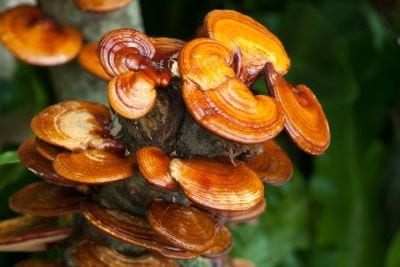 The well-known medicinal mushroom is on a par with Cordyceps, Maitake, Shiitake, Hericium and Auricularia. Although the reishi has been used primarily in East Asia for healing purposes since time immemorial, it is also native to Europe. Some even suspect its occurrence on all continents. However, since there are many similar-looking mushrooms, this hypothesis has not yet been definitively confirmed. Even in Europe, it is not so easy to distinguish the reishi from similar mushrooms. It is mainly found in damp places. It lives as a parasite and often occurs in groups. Its favoured subsoils are stumps, roots and the trunk bases of deciduous trees, especially oaks.
The well-known medicinal mushroom is on a par with Cordyceps, Maitake, Shiitake, Hericium and Auricularia. Although the reishi has been used primarily in East Asia for healing purposes since time immemorial, it is also native to Europe. Some even suspect its occurrence on all continents. However, since there are many similar-looking mushrooms, this hypothesis has not yet been definitively confirmed. Even in Europe, it is not so easy to distinguish the reishi from similar mushrooms. It is mainly found in damp places. It lives as a parasite and often occurs in groups. Its favoured subsoils are stumps, roots and the trunk bases of deciduous trees, especially oaks.
Is Reishi dangerous?
The magical powers that have been attributed to the reishi mushroom for thousands of years are no coincidence. In the meantime, modern research has been able to prove many effects, and even fathom some of them. The scientific database PubMed currently lists around 1200 articles on the vital mushroom. And more and more new research papers are being added. This clearly shows the importance of the reishi for modern medicine. It has a good reputation for defeating diseases and increasing human life expectancy.
Since the reishi has no side effects, it is completely harmless for us humans. Due to its detoxifying effect alone, slight detoxification reactions may occur at the beginning of intake. To avoid this, the dosage should be rather low at the beginning and then increase over time. The intake usually takes place over a long period of time. This applies to the treatment of specific diseases as well as to its use as a universal health support. Experience shows that it increases energy in the body and effectively supports health even under adverse circumstances.
Why should I take Reishi?
The reishi is a richly filled medicine cabinet of nature. It contains over 400 bioactive substances that have not yet been exhaustively researched. Many attempts to extract individual ingredients and use them for medicinal purposes have failed. The special effectiveness of the mushroom is probably due to the interaction of many different substances, such as the two substance groups triterpenes and polysaccharides. Both belong to the group of secondary plant substances. Experts assume a range of over 140 different triterpenes.  They have anti-inflammatory, antibacterial, tumour growth-inhibiting, liver-protecting, cholesterol-lowering and blood pressure-lowering effects. The body reacts to triterpenes in a similar way to anti-inflammatory substances or antihistamines. However, there are no side effects when taking Reishi! The approximately 100 different polysaccharides strengthen the immune system, are anti-viral, have an antioxidant effect and show antibacterial effects.
They have anti-inflammatory, antibacterial, tumour growth-inhibiting, liver-protecting, cholesterol-lowering and blood pressure-lowering effects. The body reacts to triterpenes in a similar way to anti-inflammatory substances or antihistamines. However, there are no side effects when taking Reishi! The approximately 100 different polysaccharides strengthen the immune system, are anti-viral, have an antioxidant effect and show antibacterial effects.
In the course of this article, you will learn exactly which physical ailments and diseases these miraculous ingredients can help you with. In general, mycotherapists recommend taking reishi both as prevention and for the specific treatment of acute ailments. In addition to these special medically effective substances the Reishi contains the usual macronutrients such as protein, fat, carbohydrates and fibre. It is also rich in micronutrients such as potassium, calcium, magnesium, selenium, zinc, iron, copper, vitamins B1, 2, 3 & 5, vitamin D and all essential amino acids.
What is Reishi good for?
Balm for psyche and nerves
In the area of psyche and nerves, the use of reishi has a long tradition: For hundreds of years, the Chinese have used it for sleep disorders and nervous conditions.  The mushroom has a balancing and relaxing effect. The advantage over modern sedatives and sleeping pills is that there are no side effects when taking reishi. There is also no potential for addiction. Take Reishi as capsules to shorten the time it takes you to fall asleep. At the same time, your sleep quality will increase, making you feel more awake despite the same amount of sleep time.
The mushroom has a balancing and relaxing effect. The advantage over modern sedatives and sleeping pills is that there are no side effects when taking reishi. There is also no potential for addiction. Take Reishi as capsules to shorten the time it takes you to fall asleep. At the same time, your sleep quality will increase, making you feel more awake despite the same amount of sleep time.
Scientists attribute this effect to the fact that the reishi mushroom increases sensitivity to the neurotransmitter GABA. This is lacking in stress and sleep problems. Through increased sensitivity, even a small amount of the messenger substance has a great effect. Through its ability to create mental balance, it also reduces stress-related physical symptoms. It also has a very specific effect on tense muscles. The adenosine from the Reishi mushroom inhibits the effect of the neurotransmitter acetylcholine. This results in reduced stimulus transmission between neurons and muscles. This is particularly helpful in relieving stress-related muscle tension, as often occurs in the shoulder-neck area. However, the Reishi does not only have a sedative effect on the human organism. As a harmonising mushroom, it is also a tonic for people who feel weak and dull. It awakens the spirits and helps to achieve a healthy level of activity. This makes it very popular with athletes.
Harmonisation of the hormonal system: menopause and hair loss
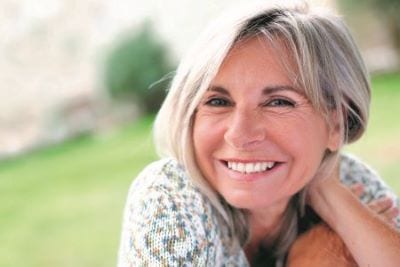 A highly valued property of the reishi is its balancing effect on the hormonal system. It helps the body to remain in balance at the endocrine level. If the balance is disturbed, as is the case during menopause, for example, the Reishi mushroom helps to restore it. In this way, it effectively counteracts unpleasant symptoms such as palpitations, sweating, nervousness and lack of drive.
A highly valued property of the reishi is its balancing effect on the hormonal system. It helps the body to remain in balance at the endocrine level. If the balance is disturbed, as is the case during menopause, for example, the Reishi mushroom helps to restore it. In this way, it effectively counteracts unpleasant symptoms such as palpitations, sweating, nervousness and lack of drive.
Thyroid gland
Many people today have a problem with their thyroid gland, a key endocrine organ. In addition to hyperthyroidism or hypothyroidism, there are several other conditions that affect the health of the thyroid gland. If the thyroid gland is out of balance, this not only affects the hormone system, but the entire organism. Here, Reishi can help to steer the function back into healthy channels. In particular, reishi counteracts unwanted attacks of the immune system on the thyroid gland. This is why it is often used for the autoimmune diseases Graves’ disease and Hashimoto’s disease. Its anti-inflammatory properties also help to combat the rather rare thyroiditis.
Hair loss
On the subject of hair loss and Reishi, the mechanisms of action have not yet been conclusively clarified. In men as well as in women, the hormone dihydrotestosterone (DHT) plays a decisive role in relation to the density of the hair on the head. The body synthesises DHT from the better-known testosterone with the help of a certain enzyme. High levels of DHT are thought to be the cause of hair loss. In a study on mice, it could now be shown that the ingredients of reishi can inhibit this specific enzyme in the production of DHT. In addition, reishi suppresses prostate growth in men. This in turn has a positive effect on the DHT level. Whether these results can be transferred 1:1 to humans is still unclear. However, since other effects of reishi have already been generalised from animals to humans, it seems reasonable to assume that this is the case. In any case, the shiny patent fungus promotes the health of the scalp, which has a positive effect on hair growth.
Lose weight with Reishi
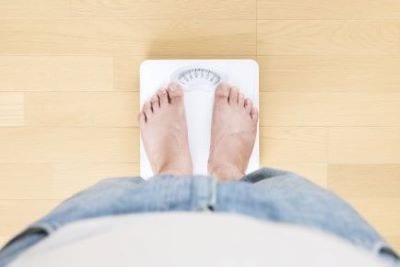 People who want to reduce their weight can benefit in many ways from reishi and its wonderful ingredients. For example, scientists showed in an animal experiment that body weight was reduced despite a high-fat diet when the animals were given Reishi. In addition, the medicinal mushroom curbed chronic inflammation in the body, which is always present in people who are overweight. It thus protects against serious secondary diseases of obesity such as cancer or autoimmune diseases.
People who want to reduce their weight can benefit in many ways from reishi and its wonderful ingredients. For example, scientists showed in an animal experiment that body weight was reduced despite a high-fat diet when the animals were given Reishi. In addition, the medicinal mushroom curbed chronic inflammation in the body, which is always present in people who are overweight. It thus protects against serious secondary diseases of obesity such as cancer or autoimmune diseases.
Lower blood sugar with Reishi
Further support for weight loss results from the ability of the medicinal mushroom to balance the blood sugar. In return, the Reishi increases the sensitivity of the body’s cells to insulin without side effects. A harmonious blood sugar level reduces the risk of food cravings, which is clearly an advantage when dieting. Obesity is usually accompanied by an imbalance of the intestinal flora. This intestinal dysbiosis is the result of an unbalanced diet and causes unfavourable digestive processes. A vicious circle develops. Successfully reducing weight is much more difficult under these conditions. This is where the polysaccharides from the reishi mushroom come in as an effective prebiotic. They support the intestinal flora in regaining its healthy balance. At the same time, the reishi reduces increased permeability of the intestine, as often occurs with obesity. This manifests itself both on the scales and in the general state of health of those affected.
Positive effects of reishi in metabolic syndrome
In our time, obesity is almost always associated with the so-called metabolic syndrome. Here, obesity is compounded by the factors of high blood pressure, dyslipidemia and insulin resistance. Acutely, the liver suffers particularly from these unfavourable conditions. The result is the so-called fatty liver. It is all the more gratifying that the triterpenes and ganodermic acids contained in reishi can lower total cholesterol both in the liver and in the blood plasma.
As a result of taking Reishi capsules, the organism synthesises less cholesterol and at the same time accelerates its metabolism. The importance of detoxification processes in weight reduction should also not be underestimated. Those who lose weight break down fat that has been stored for a long time. Various toxins are dissolved in this fat, which are released again during weight reduction. Here, the Reishi shows its effect on two levels: On the one hand, it generally stimulates the elimination of toxins from the body. On the other hand, it is a benefactor for the liver, which in turn is the leading organ in detoxification processes.
Cardiovascular diseases: When do I take Reishi?
This unique vital mushroom strengthens the entire cardiovascular system. 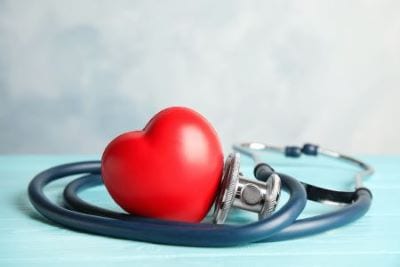 Of course, the heart as the central organ of the blood circulation benefits from the higher oxygen content of the blood through Reishi. In addition, the ingredients of Reishi inhibit lipid accumulation and platelet aggregation in the blood. This reduces the risk of blood vessels becoming clogged. These effects are supplemented by a blood-cleansing effect. The medicinal mushroom thus improves the blood circulation of the entire organism. It counteracts arteriosclerosis and ensures a balanced blood pressure. In addition, there is the experience in connection with Reishi that clinically conspicuous heart palpitations are reduced through regular intake.
Of course, the heart as the central organ of the blood circulation benefits from the higher oxygen content of the blood through Reishi. In addition, the ingredients of Reishi inhibit lipid accumulation and platelet aggregation in the blood. This reduces the risk of blood vessels becoming clogged. These effects are supplemented by a blood-cleansing effect. The medicinal mushroom thus improves the blood circulation of the entire organism. It counteracts arteriosclerosis and ensures a balanced blood pressure. In addition, there is the experience in connection with Reishi that clinically conspicuous heart palpitations are reduced through regular intake.
What is Reishi good for in cancer therapy?
In cancer therapy, reishi can support treatment and alleviate side effects. But it also has mechanisms of action that can prevent cancer from developing in the first place.
Prevention in the development of tumours
First of all, the reishi has an effect that prevents the formation of tumours. It is able to reduce oxidative stress in the body. To do this, it activates superoxide dismutase, glutathione S-transferase and laccase.  On the other hand, it supports and accelerates detoxification processes in the body, which also produce free radicals. Perhaps you are familiar with oxidative stress from the field of anti-ageing? Here, too, the goal is to bind free radicals in order to prevent their cell-destroying effect. However, the damage to body cells does not only manifest itself in signs of ageing such as wrinkles. Free radicals are also capable of permanently destroying cell DNA in such a way that cancer can develop.
On the other hand, it supports and accelerates detoxification processes in the body, which also produce free radicals. Perhaps you are familiar with oxidative stress from the field of anti-ageing? Here, too, the goal is to bind free radicals in order to prevent their cell-destroying effect. However, the damage to body cells does not only manifest itself in signs of ageing such as wrinkles. Free radicals are also capable of permanently destroying cell DNA in such a way that cancer can develop.
If you look at the current research landscape, you will notice many studies on the topic of Reishi and cancer therapy from China. Since the western diet has now also arrived in the Far East, typical civilisation diseases such as arteriosclerosis, diabetes and cancer are increasingly occurring there. One reason for this is the chronic inflammations that keep the body constantly on its toes when it is overweight. It is precisely at this point that the reishi intervenes preventively by inhibiting inflammation.
Supportive effect in the treatment of cancer
The vital mushroom supports the acute treatment of cancer on two very different levels: On the one hand, it alleviates the symptoms associated with the disease and its treatment. Pain becomes more bearable and the appetite is stimulated. If the Reishi dosage is optimally adjusted, the side effects of radiation and chemotherapy are less, while their efficiency is increased. Incidentally, a similar mitigating effect as with radiation could also be recorded with X-rays. Here, reishi accelerates the restoration of the original leuko-, erythro- and thrombocyte level. Finally, Reishi acts against the tumour itself and its growth processes without side effects. Research in recent years indicates inhibitory effects in the following cancers, among others :
- breast cancer
- prostate cancer
- ovarian cancer
- lung cancer
- liver cancer
Overall, Reishi can increase the quality of life of cancer patients and, on top of that, support their immune system. This suffers particularly under radiation and chemotherapy.
Reishi to support the immune system
A significant area of use for the reishi is in supporting the immune system.
Mode of action in the immune defence
The terpenes it contains stimulate the production of the B and T cells that are so important for the immune defence. Thanks to its antioxidant effect, it simultaneously protects the cells of the immune system from external damage.  In addition, the Reishi contains proteins that are identical to those of the body’s own defence system. Because of all these mechanisms and probably more, the Reishi mushroom is a valuable support of the human immune system. You do not have to set the dosage of the Reishi particularly high to achieve the protective and preventive effect. When taken regularly, neither viruses nor bacteria have a good chance to dock. Should they nevertheless enter the organism, the Reishi hinders their multiplication. Ultimately, the Reishi also restores a harmonious balance to the immune system. This is especially important in the case of excessive reactions such as allergies or other autoimmune diseases.
In addition, the Reishi contains proteins that are identical to those of the body’s own defence system. Because of all these mechanisms and probably more, the Reishi mushroom is a valuable support of the human immune system. You do not have to set the dosage of the Reishi particularly high to achieve the protective and preventive effect. When taken regularly, neither viruses nor bacteria have a good chance to dock. Should they nevertheless enter the organism, the Reishi hinders their multiplication. Ultimately, the Reishi also restores a harmonious balance to the immune system. This is especially important in the case of excessive reactions such as allergies or other autoimmune diseases.
Examples of immunomodulatory effect
With regard to the immunomodulating effect of the Reishi, experience is available in the following areas :
- Defence against colds and other infection
- HIV: Protection against infection and support of therapy
- Herpes Zoster: Relief of pain and skin symptoms
- Herpes simplex: Prevents the penetration of the herpes virus into the host cell.
- Autoimmune diseases: Excessive reactions of the immune system occur less frequently when the whole mushroom is taken. This effect has proven effective in cases of Hashimoto’s thyroiditis and lupus erythematosus, among others.
- Allergies: Similar to the drug cortisone, the triterpenes from reishi inhibit the release of histamines, which are responsible for red, itchy skin and swelling in allergies.
- Neurodermatitis: In the treatment of a group of children with neurodermatitis, 80% reacted positively to the intake of Reishi. Their skin condition normalised within three months.
- Rheumatoid arthritis: Reishi has an inhibitory effect on the immune system in this autoimmune disease and relieves the inflammation.
With all these positive properties, it cannot be emphasised often enough that no side effects occur during treatment with reishi. For this reason, its effect-enhancing properties can also be used without restriction. As a so-called adjuvant, the shiny patent fungus is used, for example, with vaccinations or the application of other medicinal mushrooms.
How does Reishi affect the organs?
The Reishi has a positive influence on our organs in many ways. One factor that benefits every tissue and therefore every organ is the increase in oxygen supply. The germanium from the vital mushroom ensures that the oxygen saturation of the blood increases. As a result, the cells in the body are better supplied. This effect can be particularly beneficial for those who absorb too little oxygen due to a respiratory disease. In the case of altitude sickness, reishi is an efficient means of alleviating symptoms for the same reason. Its use has already been proven in missions to the heights of the Himalayas. Another group that appreciates a higher oxygen saturation of the blood are athletes. The Reishi makes them more enduring and more powerful. In the following, we will give you an overview of various human organs. You will learn how the Reishi affects the respective organ and what this can mean for your health.
Liver
The liver is virtually the central area of action of the reishi mushroom. It supports it in its detoxifying function. On the one hand, the Reishi generally promotes the work of the body’s own detoxification enzymes. On the other hand, it protects the liver from oxidative stress and supports it in the processing of fat-soluble toxins. In the case of the liver disease hepatitis, the reishi also has an anti-inflammatory effect, and in the case of cirrhosis, an anti-fibrotic effect.
Skin
The skin benefits directly from a high liver output. Substances that promote detoxification and blood purification automatically reduce the symptoms of various skin diseases. We have already reported on allergies and neurodermatitis above.
Kidneys
Reishi stimulates the work of the kidneys. It also supports the treatment of cysts on the kidneys. When using drugs that are harmful to the kidneys, reishi dampens the side effects. Diabetics in particular often have problems with their kidneys. The kidney-protecting and blood sugar-regulating function of reishi helps them. Through its use, those affected can at best reduce their insulin dose.
Lungs
Experience has shown that the Reishi reduces the suffering of people who suffer from asthma, chronic bronchitis, shortness of breath or diseases of the upper respiratory tract. Of course, the high oxygen saturation of the blood is an advantage here.
Brain
Reishi shows protective properties in connection with the human brain. It reduces the risk of plaque formation, which can lead to dementia over time.
Stomach
The healing of stomach ulcers can be accelerated through the use of reishi. The vital mushroom supports the stomach lining in its regression. Preventive use in the case of stress, poor nutrition and smoking is also useful to protect the stomach.
Intestine
Especially with regard to our central health organ, the intestine, the reishi is a true miracle cure. It provides relief for irritable bowel syndrome, inhibits the growth of candida and seals the intestine in leaky gut syndrome. It reduces the “fattening” bacteria and restores the balance of the intestinal flora.
Reishi in the feeding dish – What does the Reishi mushroom do to animals?
Reishi works in dogs, cats, horses and other animals in a similar way to humans. When using Reishi in capsules, these can be opened shortly before use and the contents given over the food. Each keeper can also use their tried and tested tricks for administration. How high the Reishi dosage should be for your animal should ideally be discussed with your vet, veterinary practitioner or an expert in mycotherapy. It is best to call us free of charge on 040 / 334 686 370 for advice.
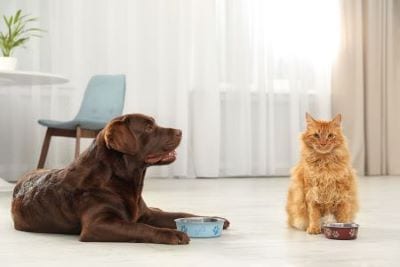 Since every animal is individual and the dosage depends on various factors such as age, constitution, vital energy and the desired area of application, no general statement can be made. However, the basic principle is always to start with the lowest possible dosage and to increase it slowly. Mycotherapy can be given to pregnant or lactating animals if indicated. If your animal has been receiving Reishi powder for a longer period of time (at least 4 weeks), it can be continued.
Since every animal is individual and the dosage depends on various factors such as age, constitution, vital energy and the desired area of application, no general statement can be made. However, the basic principle is always to start with the lowest possible dosage and to increase it slowly. Mycotherapy can be given to pregnant or lactating animals if indicated. If your animal has been receiving Reishi powder for a longer period of time (at least 4 weeks), it can be continued.
Initial deteriorations in the overall condition of your animal are first reactions to detoxification symptoms caused by Reishi – no side effects. The detoxification process shows itself in animals mainly by gastrointestinal problems and skin rashes, in dogs and cats also by red ears or ear discharge and in cats and horses by coughing. If such initial reactions occur, the dosage should be reduced or the administration interrupted for a few days.
The following effects of the Reishi – also known as Lingzhi (mushroom) – have been observed in animals so far:
- Reduction of symptoms in respiratory diseases, asthma and allergies
- Improved skin appearance in skin problems
- Reduction of pain in musculoskeletal diseases
- Strengthening in heart diseases
- Reduction of inflammatory processes in stomach and intestinal diseases
- Positive effects in accompanying cancer therapies
- Strengthening of the immune system
What should I pay attention to when taking Reishi?
The method of administration
Common forms of administration in which Reishi is offered are capsules, powder and liquid extract. 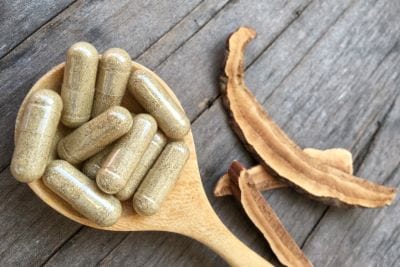 With powder, it is important that drying takes place at a maximum of 40° Celsius. At higher temperatures, the health-promoting enzymes are destroyed. The valuable ingredients of the Reishi mushroom are found in its fruiting body and also in the spores. The latter lie as a brown layer on the cap. Therefore, when buying reishi powder, make sure that it has been obtained from the whole mushroom.
With powder, it is important that drying takes place at a maximum of 40° Celsius. At higher temperatures, the health-promoting enzymes are destroyed. The valuable ingredients of the Reishi mushroom are found in its fruiting body and also in the spores. The latter lie as a brown layer on the cap. Therefore, when buying reishi powder, make sure that it has been obtained from the whole mushroom.
When does Reishi take effect?
Basically, the Reishi begins to unfold its effect in the organism immediately upon ingestion. However, this is a gentle process that takes some time to reach its full effect. We generally recommend taking Reishi for several weeks to several months. Overall, the use of reishi as a preventive and healing agent is harmless, as there are no known side effects.
How high should one dose Reishi?
It would be negligent at this point to make a blanket statement about how high the Reishi dosage should be.  This depends not only on you as a person, but also quite clearly on the respective preparation. Furthermore, it is decisive whether you want to take Reishi acutely against a certain ailment or whether it is a preventive measure. In the specific case, consult an expert in mycotherapy. We are at your disposal for a free consultation under 040 / 334 686 370.
This depends not only on you as a person, but also quite clearly on the respective preparation. Furthermore, it is decisive whether you want to take Reishi acutely against a certain ailment or whether it is a preventive measure. In the specific case, consult an expert in mycotherapy. We are at your disposal for a free consultation under 040 / 334 686 370.
Where can you buy Reishi?
There are very different suppliers who sell a wide range of preparations. When deciding what to buy, you should always make sure that the grower has a long experience with Reishi. A Lingzhi is very easy to confuse with other mushrooms. The preparations hardly ever come from wild collections. Since mushrooms absorb environmental toxins like a sponge, organic cultivation without the use of toxins is very important. Due to the high quality standards, we always recommend vital mushrooms from German organic cultivation.
Scientific studies / sources
- K.Tasaka: “Antiallergic constituents in the culture medium of Ganoderma lucidum.(I) Inhibitory effect of oleic acid on histamine release”; Agents and Actions, vol. 23, 3 / 4 (1988)
- Hiroshi Koda: “The Biologically Active Constituents of Ganoderma lucidum (Fr.) Karst. Histamine Release – Inhibitory Triterpenes”; Chem. Pharm. Bull., 33(4), 1367- 1374 (1985)
- K.Tasaka: “Antiallergic constituents in the culture medium of Ganoderma lucidum.(II) The inhibitory effect of cyclooctasulfur on histamine release”“; Agents and Actions, vol. 23, 3 / 4 (1988)
- Yearul Kabir: “Dietary Effect of Ganoderma lucidum Mushroom on Blood Pressure and Lipid Levels in Spontaneously Hypertensive Rats (SHR).”; J. Nutri. Sci. Vitaminol., 34, 433-438, 1988
- Guo-Liang Zhang: “Hepatoprotective role of ganoderma lucidum polysaccharide against BCG-induced immune liver injury in mice.”; World J. Gastroenterol 2002 August 15; 8(4): 728-733
- Ying-Hua Shich: “Evaluation of the Hepatic and Renalprotective Effects of Ganoderma lucidum in Mice.”; Am. Journal of Chinese Med., Vol. 29, Nos.3-4, pp. 501-507, 2001
- Yasuyo Hijikata, Seika Yamada: “Effect of Ganoderma lucidum on Postherpetic Neuralgia!”; Am. Journal of Chin. Med., Vol. XXVI, No. 3-4, pp. 375-381, 1998
- Hsue-Yin Hsu: “Radioprotective Effect of Ganoderma Lucidum (Leyss. Ex. Fr.) Karst after X-ray Irradiation in Mice.”; Am. Journal of Chin. Med., Vol. XVIII, Nos. 1-2, pp. 61-69, 1990
- William M.W. Cheung: “Ganoderma extract activates MAP kinases and induces the neuronal differentiation of rat Pheochromocytoma PC12 Cells.”; FEBS Letters 486 (2000) 291-296
- Seong-Kug Eo: “Possible mode of antiviral activity of acidic protein bound polysaccharide isolated from Ganoderma lucidum on herpes simplex viruses.”; Journal of Ethnopharmacology 72 (2000) 475-481
- Prof. Dr. med. Ivo Bianchi: “Moderne Mykotherapie”; Hinckel Druck, 2008
- Hobbs, C.: “Medicinal Mushrooms”; Botanica Press, 1995
Note: The described effects are based on taking medicinal mushroom powder made from the whole mushroom. Please consult your therapist before use.






